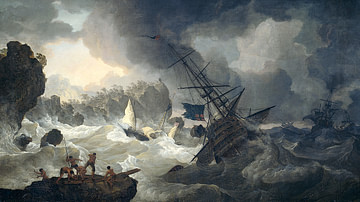Review

| Rating: | |
|---|---|
| Title: | Samuel Pepys and the Strange Wrecking of the Gloucester: The Shipwreck that Shocked Restoration Britain |
| Author: | Nigel Pickford |
| Audience: | General Public |
| Difficulty: | Easy |
| Publisher: | Pegasus Books |
| Published: | 2023 |
| Pages: | 304 |
Nigel Pickford’s "Samuel Pepys and the Strange Wrecking of the Gloucester" is a comprehensive account of the shipwreck that shook Stuart Britain in the 1680s and suggests a new interpretation of the events around the diarist Samuel Pepys. Pickford’s novelistic and discursive tone might not satisfy academic historians, but it is a very entertaining and informative read for all history enthusiasts.
In 1682, upon the invitation of his brother King Charles II, James, the Duke of York, came back to England after years of exile in Scotland to take up his position as heir to the throne. James first traveled to England without his wife, with her pregnancy preventing her from accompanying him. To reunite with her and take her back to England, James thus set sail to Edinburgh in a fleet of eight ships. However, on May 6th, 1682, the ship James was on, HMS Gloucester, struck a sandbank and quickly sank, taking the lives of 150 people, including some of James’ courtiers.
In Samuel Pepys and the Strange Wrecking of the Gloucester: The Shipwreck that Shocked Restoration Britain, Nigel Pickford traces back HMS Gloucester’s journey throughout the 34 chapters of the book, from the sailing at Portsmouth to the fatal wreck off the eastern coast of England. The division of the chapters allows the reader to follow step by step Gloucester's final journey and also learn about the many historical figures involved in these events. Indeed, one of the strengths of the book is the attention it gives to all who were on the Gloucester on her final journey from royals to courtiers and seamen. The study of specific individual figures tends to be neglected in existing research on the shipwreck, but Pickford’s care toward unveiling the individual stories of seamen who perished shows how this catastrophe did not simply have political consequences - which Pickford also explores - but also directly impacted the often financially struggling families of seamen.
Pickford also looks at who was not aboard the Gloucester as he takes a particular interest in the figure of Samuel Pepys, who was offered a place aboard but declined it. Pickford thus seeks to revisit the enduring narrative of the shipwreck by asking what was the physical condition of the Gloucester the morning it sailed and whether there could be a connection between the ship's condition and Pepys’ decline to the offer. However, the argument of Pepys' significance in shedding new light on the narrative of the shipwreck only becomes clear at the end of the book in Chapter 32. Therefore, although the author’s argument works, Pickford’s discursive tone tends to take the focus off of Samuel Pepys, since it is not always obvious how he is the common thread between chapters.
One clear common thread throughout the book is the richness of the archives Pickford uses. He takes great care of using letters and diaries written by people who were part of the royal fleet, as well as contemporary paintings, to provide an account as unmediated as possible. Pickford is a well-known maritime historian and has worked with companies that locate shipwrecks. His expertise is particularly apparent in the last chapters when he explores how and where the Gloucester was discovered. Pickford’s comprehensive knowledge and enthusiasm for shipwrecks turn the book into both an enjoyable and valuable read. He lets readers better understand not only the significance of the sinking of the Gloucester in 1682 but also the historical importance of the recent reveal of Gloucester's shipwreck in June 2022.
About the Reviewer
Cite This Work
APA Style
Angers, S. (2023, February 09). Samuel Pepys and the Strange Wrecking of the Gloucester: The Shipwreck that Shocked Restoration Britain. World History Encyclopedia. Retrieved from https://www.worldhistory.org/review/299/samuel-pepys-and-the-strange-wrecking-of-the-glouc/
Chicago Style
Angers, Severine. "Samuel Pepys and the Strange Wrecking of the Gloucester: The Shipwreck that Shocked Restoration Britain." World History Encyclopedia. Last modified February 09, 2023. https://www.worldhistory.org/review/299/samuel-pepys-and-the-strange-wrecking-of-the-glouc/.
MLA Style
Angers, Severine. "Samuel Pepys and the Strange Wrecking of the Gloucester: The Shipwreck that Shocked Restoration Britain." World History Encyclopedia. World History Encyclopedia, 09 Feb 2023. Web. 09 Apr 2025.


